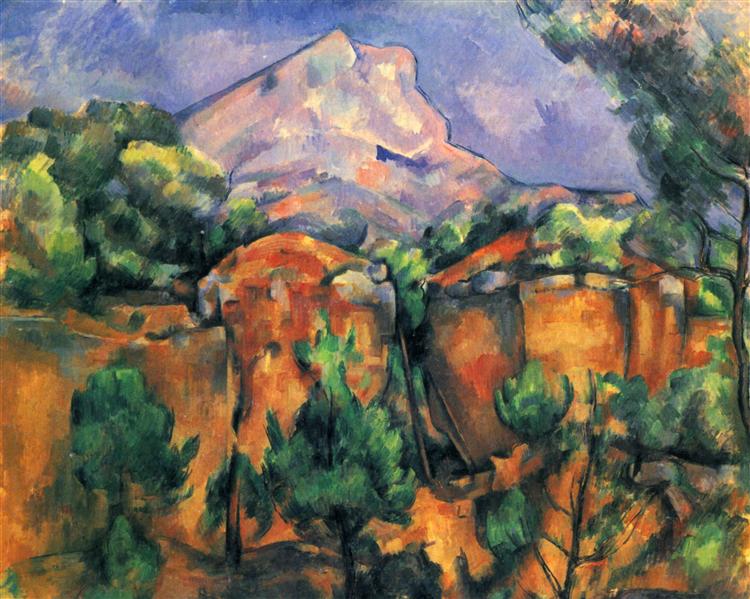Beskrivelse
Maleriet "Mont Sainte-Victoire" fra 1897, skabt af Paul Cézanne, er et emblematisk værk, der ikke kun indkapsler essensen af det provencalske landskab, men også kommer ind i dybden af den kunstneriske innovation i det nittende århundrede. Dette arbejde er en del af en bredere serie, som Cézanne lavede på dette ikoniske bjerg, der står som et symbol på det område, hvor meget af hans liv gik. I dette arbejde er bjerget repræsenteret med en karakteristisk tilgang, der afslører kunstnerens eksperimentering med form, farve og rumlig opfattelse.
Ved første øjekast er sammensætningen kendetegnet ved en næsten geometrisk tilgang, hvor formerne er bygget med en række overlappende fly, der bekræfter påvirkningen af kubismen, som Cézanne ville begynde at udvikle sig mere intenst i hans mest modne arbejde. Selve bjerget med sit fremtrædende topmøde og dets ulige skråninger ligger i midten af scenen, der dominerer horisonten og understreger ikke kun sin majestæt, men også forbindelsen, som kunstneren føler med det lokale landskab. Dette kompositionsvalg kan fortolkes som et forsøg på at forankre naturen i en sammenhæng, der går ud over den rent repræsentative; Det er en søgning efter essensen af stedet, et vendepunkt i overgangen mellem impressionisme og kubisme.
Brugen af farve i dette arbejde er især bemærkelsesværdig. Cézanne bruger en palet, der kombinerer toner af blå, grøn og oker, hvilket skaber en pulserende dialog mellem landskabet og himlen. De grønne nuancer, der dækker bjergets skråninger, er kontrasteret med de blå himmel Fra Cézanne. Der er en håndgribelig interesse i, hvordan lys påvirker overfladen, der omdanner det naturlige miljø til en rig og sensorisk visuel oplevelse. Teksturen skabt af det løse børstesteknik tilføjer en fysisk dimension til malingen, næsten som om seeren kunne røre ved de bløde bakker eller føle den brise, der løber gennem landskabet.
Selvom værket mangler menneskelige karakterer, antyder tilstedeværelsen af landskabselementer - såsom træer i forgrunden - en intim oplevelse af naturen selv. Cézanne undgik ofte at inkludere figurer i dets landskaber og foretrækker, at seerens opmærksomhed fokuserede på forholdet mellem jorden og maleriets struktur. Denne tilgang giver seeren mulighed for at opleve landskabet fra kunstnerens perspektiv og inviterer ham til ikke kun at overveje det, der er til stede, men også hvad han føler i miljøet.
Et interessant aspekt af "Mont Sainte-Victoire" er dens plads i udviklingen af moderne kunst. Cézanne betragtes som en forløber for kubismen, men hans position var unik; Han begrænsede sig ikke til at fragmentere billedet, men søgte gennem syntese for at fange essensen af de genstande, han observerede. Hans arbejde var grundlæggende for senere kunstnere, såsom Pablo Picasso og Georges Braque, der var inspireret af deres tilgang til form og farve.
Afslutningsvis er "Mont Sainte-Victoire" meget mere end en geografisk repræsentation af et specifikt sted; Det er en meditation om natur, opfattelse og kunstnerisk form. Cézanne skildrer ikke kun bjerget; Han inviterer hende til at dele hendes følelsesmæssige liv og omdanne landskabsoplevelsen til et værk, der trodser konventionerne i hendes tid og åbner stier til de nye former for det tyvende århundrede kunst. Bjerget bliver således et symbol ikke kun på sin oprindelige region, men af en tilgang til kunst, der søger at indkapsle kompleksiteten af menneskelig oplevelse gennem forholdet til den naturlige verden.
KUADROS ©, en berømt maling på din væg.
Håndlavede olie -malerier med kvaliteten af professionelle kunstnere og den karakteristiske segl af KUADROS ©.
Billeder Reproduktionstjeneste med tilfredshedsgaranti. Hvis du ikke er helt tilfreds med kopien af dit maleri, refunderer vi dine penge 100%.

